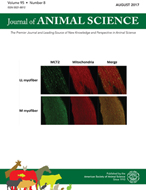-
Views
-
Cite
Cite
A. L. Goetsch, T. A. Gipson, A. R. Askar, R. Puchala, Invited review: Feeding behavior of goats,, Journal of Animal Science, Volume 88, Issue 1, January 2010, Pages 361–373, https://doi.org/10.2527/jas.2009-2332
Close - Share Icon Share
ABSTRACT
Factors influencing the feeding behavior of goats include grazing management practices, type of vegetation and season, breed and stage of production, group size, and properties of diets fed in confinement. Considerable information has been gathered from visual observation during daylight. However, tools are now available to characterize the feeding behavior of goats while grazing and while in confinement throughout the day. Global positioning system collars can be used to assess horizontal and vertical distances traveled, up or down position of the head, and movement within pasture or rangeland areas. A commercially available leg activity monitor allows estimation of the number of steps and time spent standing, lying, and moving rapidly without grazing. However, these measurements do not directly determine grazing. Therefore, prediction equations based on visual observation must be developed. Classification tree analysis is a robust method in developing these equations because the decision tree can be pruned or expanded to provide the best fit. Another equipment system determines time spent eating, ruminating, and remaining idle from the pattern of jaw movement. In addition to use of n-alkanes as internal markers to estimate digestibility, their profile can provide an indication of the botanical composition of the selected diet. Automated feeding systems for confined goats permit determinations such as number of feeder visits and meals, eating time, and rate and pattern of feed intake. Heart rate measured while goats are in normal production settings can be used to predict total energy expenditure through multiplication by energy expenditure per heartbeat of individual animals. To partition the activity energy cost, an estimate of ME intake or measures of changes in body energy status and milk energy yield are needed to determine other sources of heat to be subtracted from total energy expenditure. These methods create the opportunity to gain a fuller understanding of factors influencing the feeding behavior of goats and the relationships with levels and efficiencies of production.





